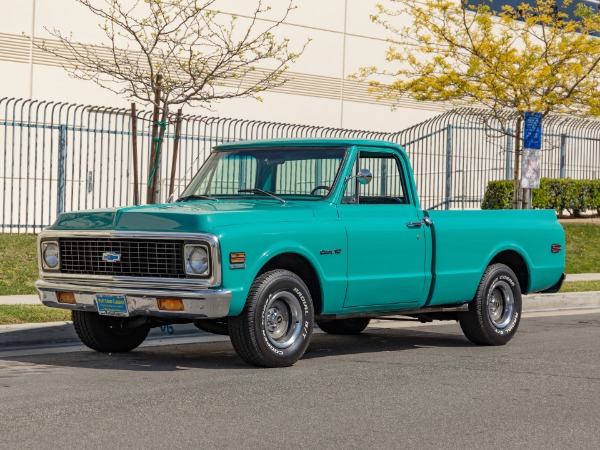1972 Chevrolet C10: A Stalwart of American Truck Legacy
Truck enthusiasts, gear-heads, and historians alike will agree: the 1972 Chevrolet C10 is more than just a truck. It’s a symbol of an era, a testament to Chevrolet’s undying commitment to functionality and design. Let’s embark on a nostalgic journey and explore this iconic masterpiece.
In the vast tapestry of automotive history, the 1972 Chevrolet C10 occupies a significant place. But to truly appreciate its position, one must embark on a journey back in time, understanding Chevrolet’s heritage and the socio-economic landscape of the United States.
The Foundations of Chevrolet
Chevrolet, often colloquially referred to as ‘Chevy,’ was birthed in the early 20th century. Founded in 1911 by Louis Chevrolet and ousted GM founder William C. Durant, Chevrolet started as a fierce competitor to the more established Ford. In the backdrop of the industrial boom, Chevrolet quickly became synonymous with American resilience, innovation, and spirit.
Post-War America and Chevrolet’s Truck Line
With the conclusion of World War II, America was poised for significant transformations. Urbanization was on the rise, the highway system was expanding, and there was an increasing demand for versatile vehicles. Trucks, which were primarily seen as utilitarian workhorses before the war, began to find an audience among regular consumers.
Chevrolet, sensing this shift, introduced the Advance Design trucks in 1947. These were bigger, stronger, and more streamlined than their predecessors. As the 1950s progressed, Chevrolet’s trucks underwent further refinements, resulting in the Task Force Series in 1955. These models, with their V8 engines and sleek designs, showcased Chevy’s commitment to combining power with aesthetics.
The Advent of the C/K Series
The 1960s marked a pivotal era for Chevrolet. As rock ‘n’ roll, civil rights movements, and space exploration defined America’s character, Chevrolet introduced the C/K series in 1960. This new line, categorized by rear-wheel (C) and four-wheel (K) drive configurations, was groundbreaking. These trucks were not just functional; they were stylish, becoming a symbol of both the hard-working American and the emerging suburban family.
As the first generation of the C/K series progressed, Chevrolet made several enhancements, both aesthetically and mechanically. The culmination of this decade-long refinement was the 1972 Chevrolet C10.
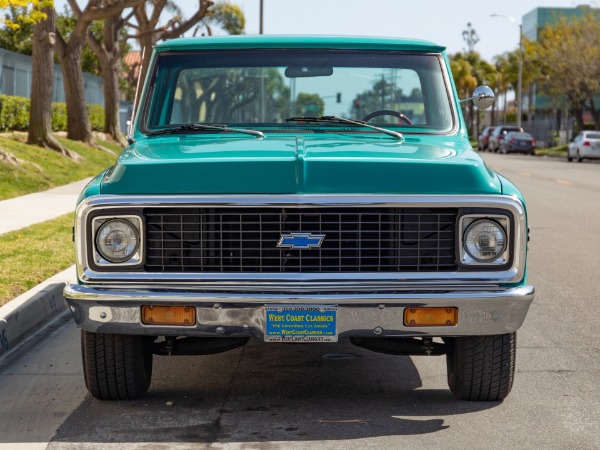
1972: A Pivotal Year in Automotive Design
By 1972, America was at a crossroads. The Vietnam War, the Watergate scandal, and the energy crisis were looming large. Yet, amidst this tumultuous backdrop, the 1972 Chevrolet C10 stood as a beacon of reliability and design ingenuity. It encapsulated the very essence of a nation looking to strike a balance between its storied past and an uncertain yet promising future.
The Genius Minds: Designers Behind the 1972 Chevrolet C10
When we discuss the 1972 Chevrolet C10, it’s impossible not to shine a light on the brilliant minds responsible for its conceptualization and design. These designers, under the overarching guidance of General Motors, didn’t just craft vehicles—they shaped the future of automotive aesthetics and functionality.
Bill Mitchell: A Visionary at Helm
Bill Mitchell, the Vice President of Styling at General Motors from 1958 to 1977, was at the vanguard of many of Chevrolet’s iconic designs. Mitchell inherited the reins from the legendary Harley Earl and continued to push the envelope in terms of design innovation.
The 1972 C10, while being a product of collective genius, bore the hallmarks of Mitchell’s philosophy: streamlined designs with a robust character. Under his leadership, cars and trucks from Chevrolet in the late ’60s and early ’70s took on a sculpted, muscular appearance, evoking a sense of both power and grace. Mitchell believed in clean lines, cohesive design, and a harmonious blend of form and function, which clearly manifested in the C10.
The Design Team: Diverse Brilliance
While Mitchell was a central figure, the design of the C10 was the result of a collaborative effort by a diverse group of talented individuals at Chevrolet. This team, which included engineers, designers, and artisans, worked tirelessly to translate sketches into tangible, road-ready machines.
Chuck Jordan, another influential figure at GM and later Mitchell’s successor, was known to have been involved in various projects around this time. Jordan’s knack for modern aesthetics and forward-thinking might have been instrumental in refining the C10’s design, giving it the futuristic edge for which 1970s vehicles were becoming known.
Irvin Rybicki, another key player in GM’s design history and Jordan’s successor, also contributed to the design ethos of the era. His belief in the interplay of light and shadow in automotive design added depth and dimension to vehicles like the C10.
The Process: From Idea to Asphalt
The design process was an intricate ballet of hand sketches, clay models, wind tunnel tests, and countless revisions. The objective was always clear: to create a truck that was both aesthetically pleasing and incredibly functional. The wide wheelbase, the signature grille, the cabin design—all were the result of countless hours of deliberation, testing, and refinement.
Moreover, the designers had to consider the changing desires of the American public. The late ’60s and early ’70s marked a period of societal change, and vehicles, especially those as iconic as the C10, had to reflect this shift. They were no longer just tools but also expressions of individuality and style.
OUR 1972 CHEVROLET C10 CUSTOM PICK UP:
‘We are delighted to showcase a stellar representation of the 1972 Chevrolet C10 1/2 Ton Full Size Fleetside Short Bed Pickup, complete with its robust 350 V8 engine and an automatic transmission accentuated by a B&M shifter.
Witnessing this truck firsthand is essential to truly grasp its remarkable condition. The 350 V8 engine is impressively powerful and agile, complemented by an automatic transmission that seamlessly glides through each gear.
In essence, this 1972 edition of the iconic Full Size C10 1/2 ton pickup is not just a rare gem because of its pristine, ready-to-go state but also for its continually increasing value, guaranteed daily usability, and undeniable charisma. A quintessential classic American truck, it’s a showstopper in every sense!‘
1. Engine: The Heartbeat of the C10
The heart of the 1972 C10 is its 350 V8 engine. This powertrain, a marvel of its time, boasts a displacement of 5.7 liters. It is characterized by its robustness, delivering a hearty horsepower that made the C10 not just a utilitarian vehicle, but also a spirited one, ready for the open road. The engine’s design prioritized efficiency and durability, making it a favorite for many Chevrolet enthusiasts. Its carbureted fuel system and overhead valve configuration made it both reliable and relatively easy to maintain, factors that contributed significantly to its enduring popularity.
2. Transmission: Smooth Shifting Personified
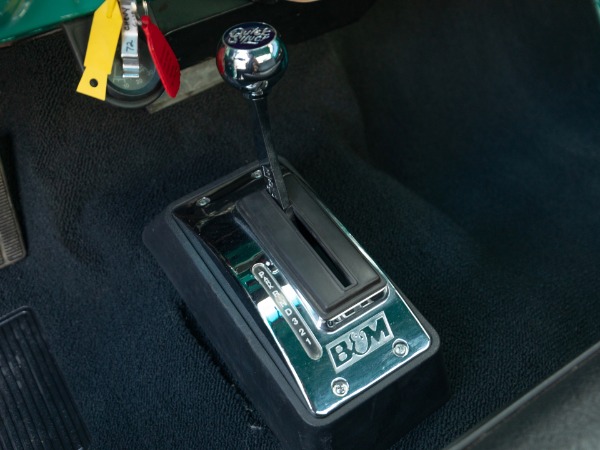
B&M Shifter
Paired with the 350 V8 engine is an automatic transmission, enhanced by a B&M shifter, known for its performance-driven design. The transmission was engineered to offer smooth and effortless gear shifts. Ensuring that the power from the engine was efficiently translated to the wheels. This combination allowed drivers to experience both the raw power of the truck and the refined, smooth driving experience, a balance that was hard to achieve in many vehicles of that era.
3. Suspension: Bridging Comfort and Capability
The 1972 Chevrolet C10’s suspension system was one of its standout features. While trucks are often associated with rigid rides due to their work-oriented nature, the C10 broke the mold. With its coil spring rear suspension replacing the more traditional leaf springs, the C10 offered a more comfortable ride, absorbing road imperfections with greater ease. This design choice was both innovative and practical, enhancing the truck’s versatility by making it suitable for both work and leisure.
4. Body Specifications: A Blend of Function and Form
The C10’s Fleetside Short Bed design reflected a perfect marriage of functionality and aesthetics. The Fleetside design, characterized by its smooth exterior and absence of external fenders, gave the truck a sleek appearance. This design not only improved the vehicle’s aerodynamics but also provided a more expansive loading area, emphasizing the truck’s dual nature as a workhorse and a style icon. The body, made of durable materials, was built to withstand the test of time, and its robust construction was evident in its resilience against both the elements and the rigors of daily use.
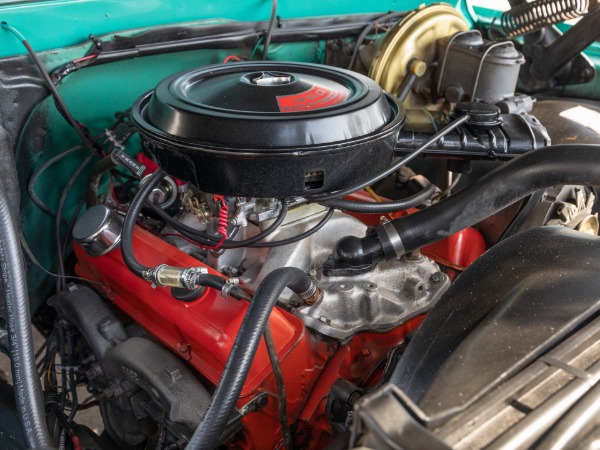
ENGINE SIZE: 350/350HP V8
CLICK HERE TO VIEW OUR OTHER CHEVROLET INVENTORY:
Historical Significance: Reflecting an Era
The 1972 C10 came at a time when America was undergoing significant changes. From the music of the time to the socio-political landscape, everything was evolving, and so were the vehicles. The C10, with its refined design and improved functionality, was Chevrolet’s answer to this changing landscape. Making trucks appealing not just as utility vehicles but also as daily drivers.
Impact and Legacy: The Road Ahead
T highlighted Chevrolet’s ability to adapt and innovate. With its coil spring rear suspension replacing the traditional leaf springs, it offered a smoother ride. Its design and functionality made it popular among fleets and families alike.
Its DNA is evident in Chevrolet’s modern lineup of trucks. Moreover, it has become a darling of the restoration community. Vintage truck enthusiasts and collectors seek it out, with many restored models fetching impressive figures at auctions.
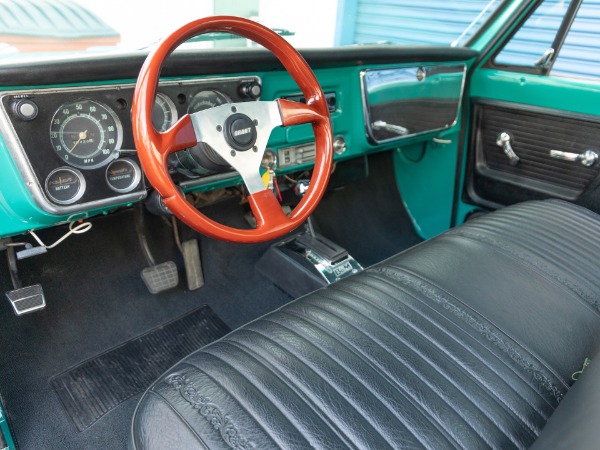
Our 1972 Chevrolet C10 Custom Pick Up Interior
Conclusion: Celebrating the 1972 Chevrolet C10
The 1972 Chevrolet C10 is more than metal, rubber, and fabric. It’s a story. A story of Chevrolet’s commitment, of America’s changing landscape, and of the timeless appeal of a well-designed truck. Cheers to an icon!

